LINCOLN MKX 2009 Owners Manual
Manufacturer: LINCOLN, Model Year: 2009, Model line: MKX, Model: LINCOLN MKX 2009Pages: 307, PDF Size: 2.18 MB
Page 231 of 307
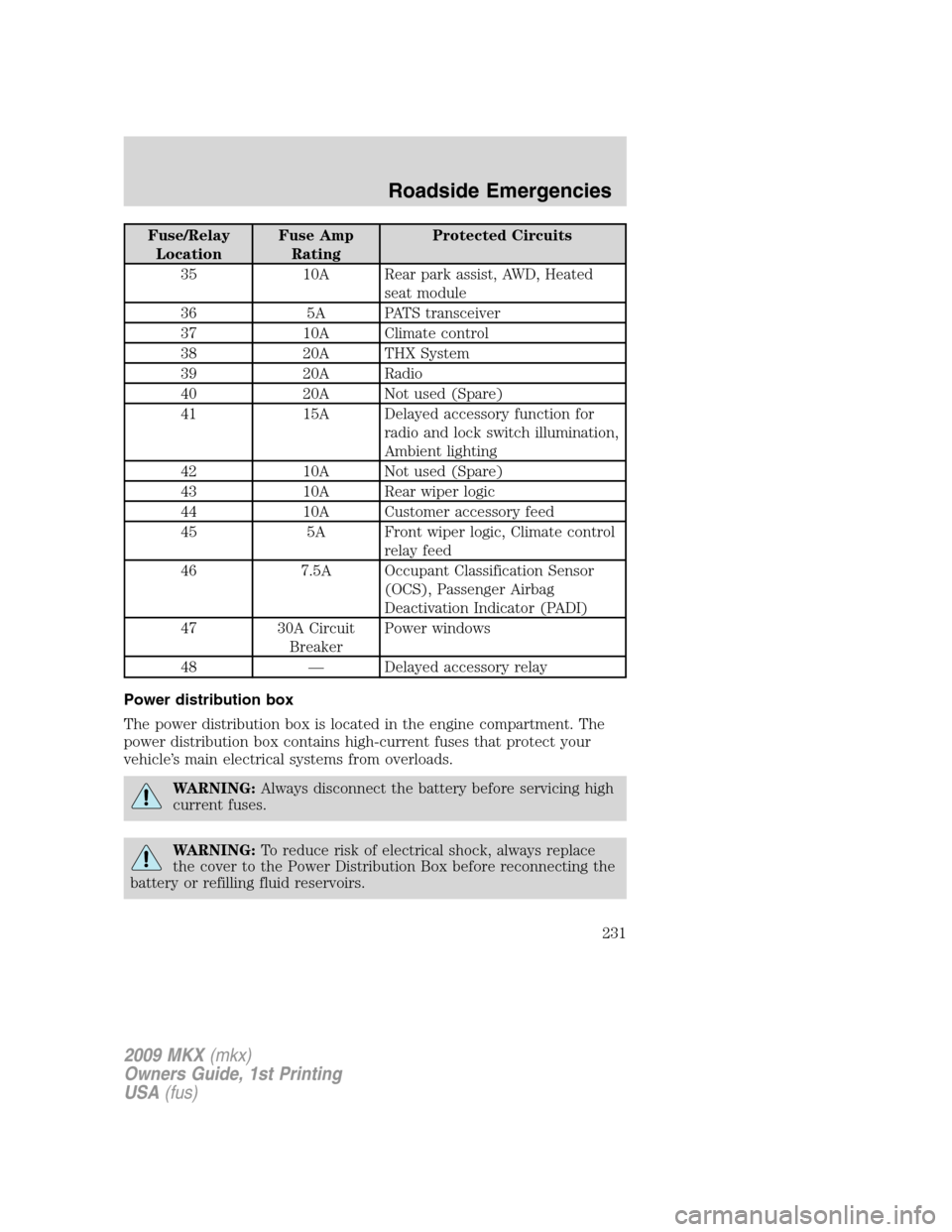
Fuse/Relay
LocationFuse Amp
RatingProtected Circuits
35 10A Rear park assist, AWD, Heated
seat module
36 5A PATS transceiver
37 10A Climate control
38 20A THX System
39 20A Radio
40 20A Not used (Spare)
41 15A Delayed accessory function for
radio and lock switch illumination,
Ambient lighting
42 10A Not used (Spare)
43 10A Rear wiper logic
44 10A Customer accessory feed
45 5A Front wiper logic, Climate control
relay feed
46 7.5A Occupant Classification Sensor
(OCS), Passenger Airbag
Deactivation Indicator (PADI)
47 30A Circuit
BreakerPower windows
48 — Delayed accessory relay
Power distribution box
The power distribution box is located in the engine compartment. The
power distribution box contains high-current fuses that protect your
vehicle’s main electrical systems from overloads.
WARNING:Always disconnect the battery before servicing high
current fuses.
WARNING:To reduce risk of electrical shock, always replace
the cover to the Power Distribution Box before reconnecting the
battery or refilling fluid reservoirs.
2009 MKX(mkx)
Owners Guide, 1st Printing
USA(fus)
Roadside Emergencies
231
Page 232 of 307
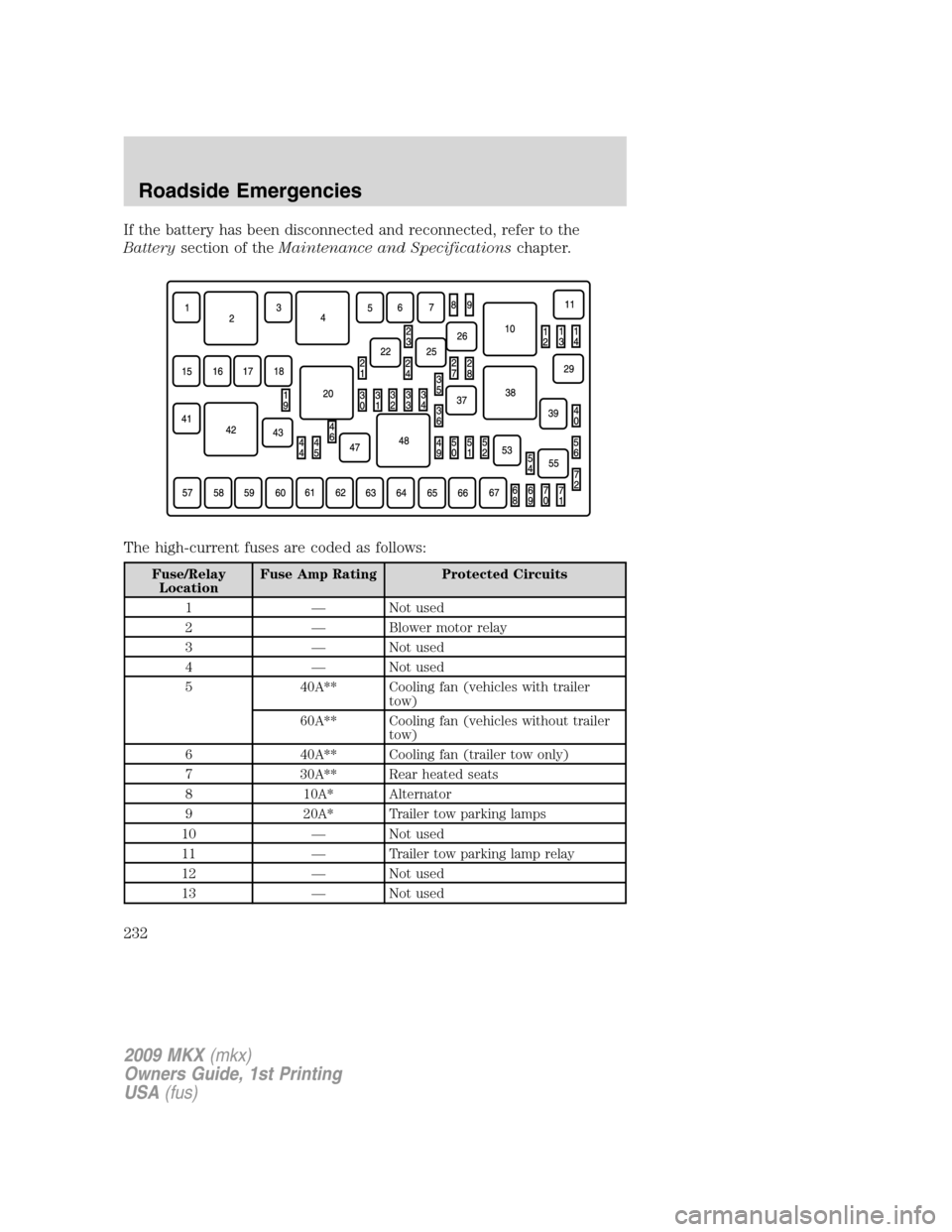
If the battery has been disconnected and reconnected, refer to the
Batterysection of theMaintenance and Specificationschapter.
The high-current fuses are coded as follows:
Fuse/Relay
LocationFuse Amp Rating Protected Circuits
1 — Not used
2 — Blower motor relay
3 — Not used
4 — Not used
5 40A** Cooling fan (vehicles with trailer
tow)
60A** Cooling fan (vehicles without trailer
tow)
6 40A** Cooling fan (trailer tow only)
7 30A** Rear heated seats
8 10A* Alternator
9 20A* Trailer tow parking lamps
10 — Not used
11 — Trailer tow parking lamp relay
12 — Not used
13 — Not used
2009 MKX(mkx)
Owners Guide, 1st Printing
USA(fus)
Roadside Emergencies
232
Page 233 of 307
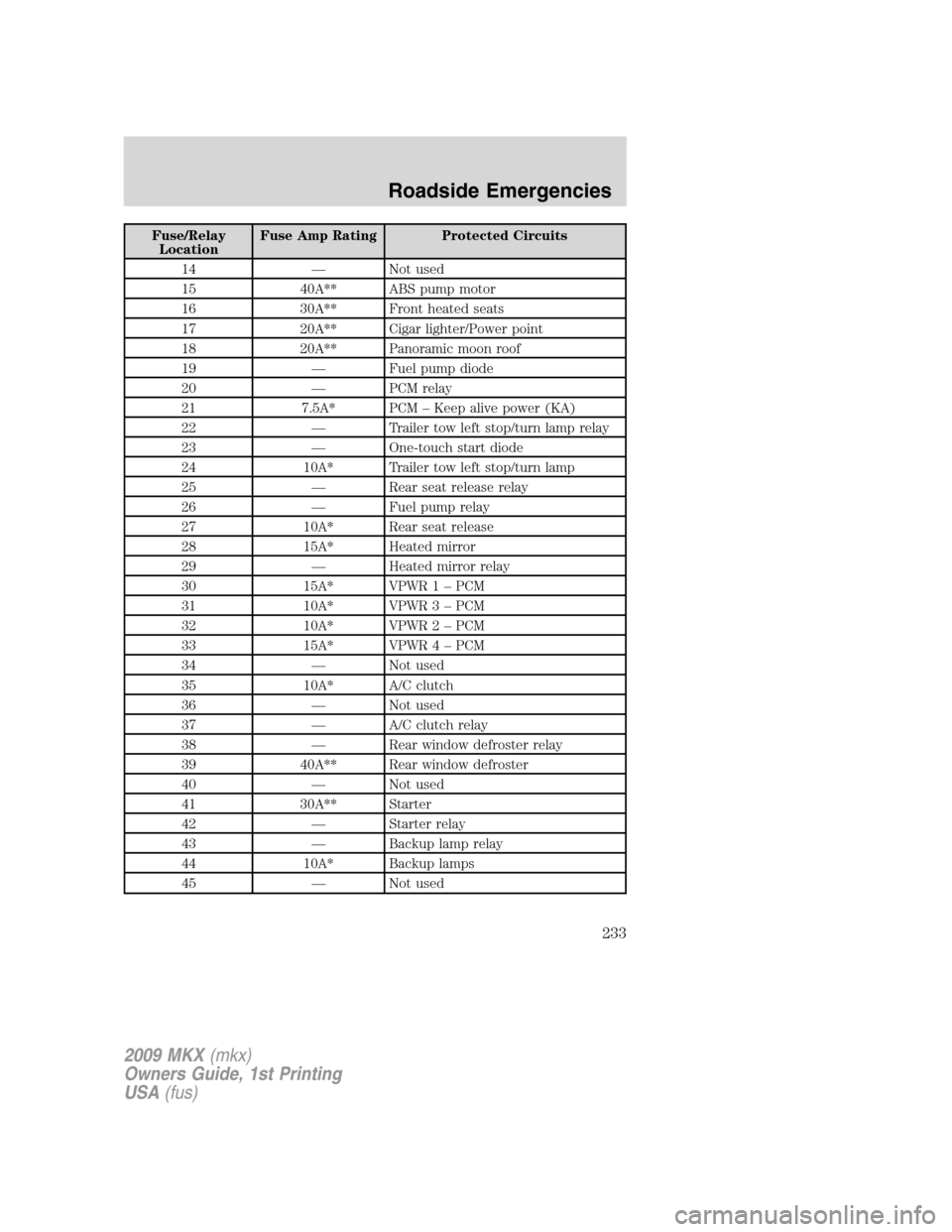
Fuse/Relay
LocationFuse Amp Rating Protected Circuits
14 — Not used
15 40A** ABS pump motor
16 30A** Front heated seats
17 20A** Cigar lighter/Power point
18 20A** Panoramic moon roof
19 — Fuel pump diode
20 — PCM relay
21 7.5A* PCM – Keep alive power (KA)
22 — Trailer tow left stop/turn lamp relay
23 — One-touch start diode
24 10A* Trailer tow left stop/turn lamp
25 — Rear seat release relay
26 — Fuel pump relay
27 10A* Rear seat release
28 15A* Heated mirror
29 — Heated mirror relay
30 15A* VPWR1–PCM
31 10A* VPWR3–PCM
32 10A* VPWR2–PCM
33 15A* VPWR4–PCM
34 — Not used
35 10A* A/C clutch
36 — Not used
37 — A/C clutch relay
38 — Rear window defroster relay
39 40A** Rear window defroster
40 — Not used
41 30A** Starter
42 — Starter relay
43 — Backup lamp relay
44 10A* Backup lamps
45 — Not used
2009 MKX(mkx)
Owners Guide, 1st Printing
USA(fus)
Roadside Emergencies
233
Page 234 of 307
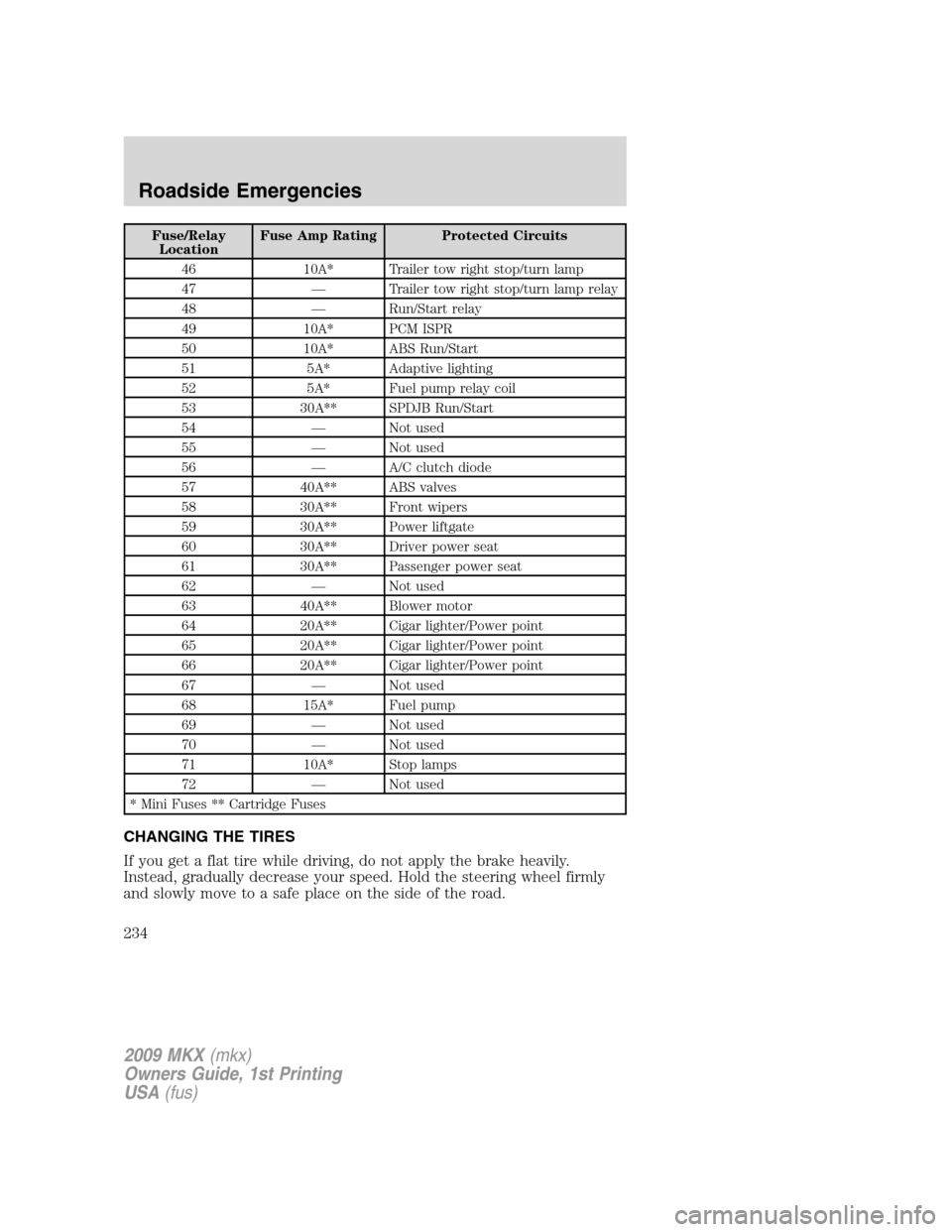
Fuse/Relay
LocationFuse Amp Rating Protected Circuits
46 10A* Trailer tow right stop/turn lamp
47 — Trailer tow right stop/turn lamp relay
48 — Run/Start relay
49 10A* PCM ISPR
50 10A* ABS Run/Start
51 5A* Adaptive lighting
52 5A* Fuel pump relay coil
53 30A** SPDJB Run/Start
54 — Not used
55 — Not used
56 — A/C clutch diode
57 40A** ABS valves
58 30A** Front wipers
59 30A** Power liftgate
60 30A** Driver power seat
61 30A** Passenger power seat
62 — Not used
63 40A** Blower motor
64 20A** Cigar lighter/Power point
65 20A** Cigar lighter/Power point
66 20A** Cigar lighter/Power point
67 — Not used
68 15A* Fuel pump
69 — Not used
70 — Not used
71 10A* Stop lamps
72 — Not used
* Mini Fuses ** Cartridge Fuses
CHANGING THE TIRES
If you get a flat tire while driving, do not apply the brake heavily.
Instead, gradually decrease your speed. Hold the steering wheel firmly
and slowly move to a safe place on the side of the road.
2009 MKX(mkx)
Owners Guide, 1st Printing
USA(fus)
Roadside Emergencies
234
Page 235 of 307
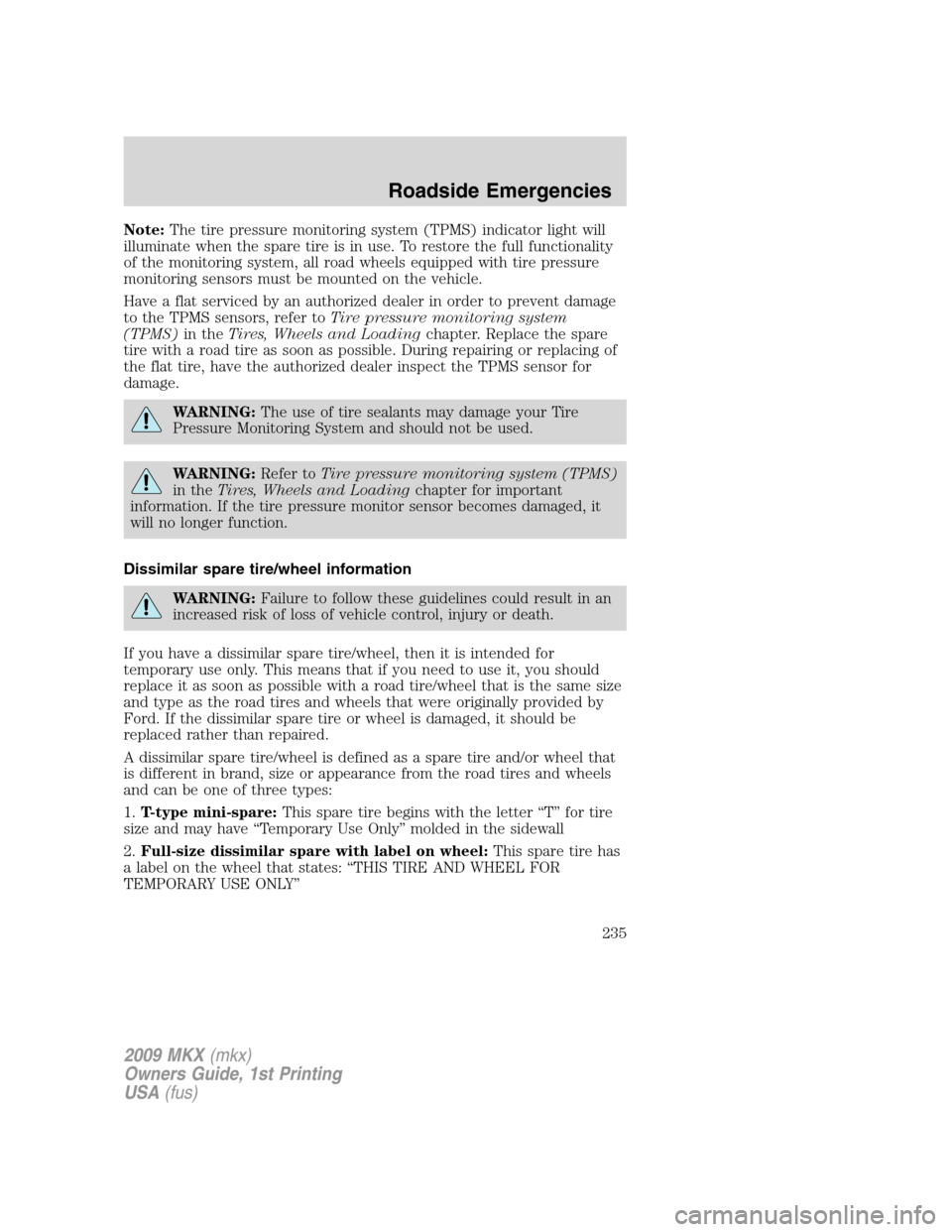
Note:The tire pressure monitoring system (TPMS) indicator light will
illuminate when the spare tire is in use. To restore the full functionality
of the monitoring system, all road wheels equipped with tire pressure
monitoring sensors must be mounted on the vehicle.
Have a flat serviced by an authorized dealer in order to prevent damage
to the TPMS sensors, refer toTire pressure monitoring system
(TPMS)in theTires, Wheels and Loadingchapter. Replace the spare
tire with a road tire as soon as possible. During repairing or replacing of
the flat tire, have the authorized dealer inspect the TPMS sensor for
damage.
WARNING:The use of tire sealants may damage your Tire
Pressure Monitoring System and should not be used.
WARNING:Refer toTire pressure monitoring system (TPMS)
in theTires, Wheels and Loadingchapter for important
information. If the tire pressure monitor sensor becomes damaged, it
will no longer function.
Dissimilar spare tire/wheel information
WARNING:Failure to follow these guidelines could result in an
increased risk of loss of vehicle control, injury or death.
If you have a dissimilar spare tire/wheel, then it is intended for
temporary use only. This means that if you need to use it, you should
replace it as soon as possible with a road tire/wheel that is the same size
and type as the road tires and wheels that were originally provided by
Ford. If the dissimilar spare tire or wheel is damaged, it should be
replaced rather than repaired.
A dissimilar spare tire/wheel is defined as a spare tire and/or wheel that
is different in brand, size or appearance from the road tires and wheels
and can be one of three types:
1.T-type mini-spare:This spare tire begins with the letter “T” for tire
size and may have “Temporary Use Only” molded in the sidewall
2.Full-size dissimilar spare with label on wheel:This spare tire has
a label on the wheel that states: “THIS TIRE AND WHEEL FOR
TEMPORARY USE ONLY”
2009 MKX(mkx)
Owners Guide, 1st Printing
USA(fus)
Roadside Emergencies
235
Page 236 of 307
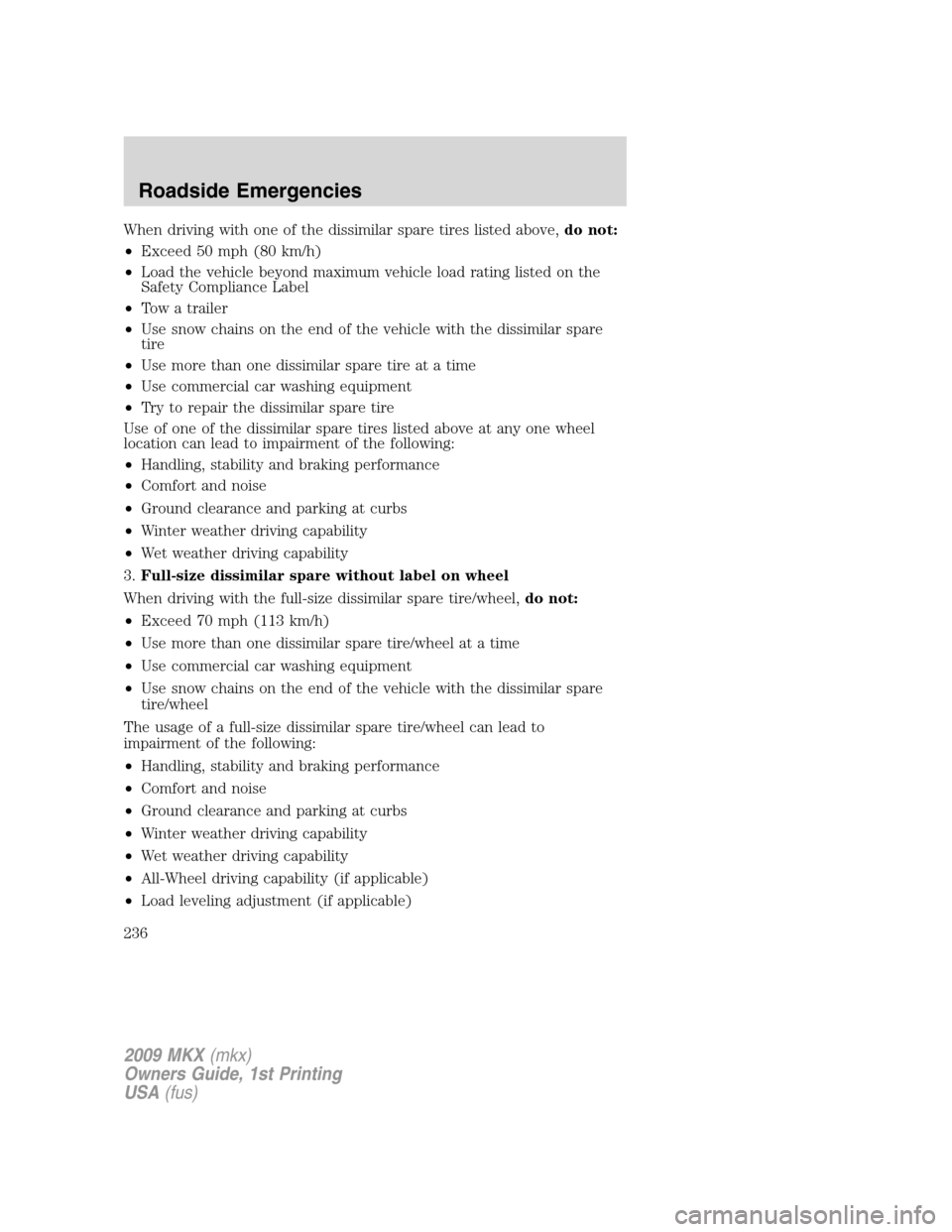
When driving with one of the dissimilar spare tires listed above,do not:
•Exceed 50 mph (80 km/h)
•Load the vehicle beyond maximum vehicle load rating listed on the
Safety Compliance Label
•Tow a trailer
•Use snow chains on the end of the vehicle with the dissimilar spare
tire
•Use more than one dissimilar spare tire at a time
•Use commercial car washing equipment
•Try to repair the dissimilar spare tire
Use of one of the dissimilar spare tires listed above at any one wheel
location can lead to impairment of the following:
•Handling, stability and braking performance
•Comfort and noise
•Ground clearance and parking at curbs
•Winter weather driving capability
•Wet weather driving capability
3.Full-size dissimilar spare without label on wheel
When driving with the full-size dissimilar spare tire/wheel,do not:
•Exceed 70 mph (113 km/h)
•Use more than one dissimilar spare tire/wheel at a time
•Use commercial car washing equipment
•Use snow chains on the end of the vehicle with the dissimilar spare
tire/wheel
The usage of a full-size dissimilar spare tire/wheel can lead to
impairment of the following:
•Handling, stability and braking performance
•Comfort and noise
•Ground clearance and parking at curbs
•Winter weather driving capability
•Wet weather driving capability
•All-Wheel driving capability (if applicable)
•Load leveling adjustment (if applicable)
2009 MKX(mkx)
Owners Guide, 1st Printing
USA(fus)
Roadside Emergencies
236
Page 237 of 307

When driving with the full-size dissimilar spare tire/wheel additional
caution should be given to:
•Towing a trailer
•Driving vehicles equipped with a camper body
•Driving vehicles with a load on the cargo rack
Drive cautiously when using a full-size dissimilar spare tire/wheel and
seek service as soon as possible.
Stopping and securing the vehicle
1. Park on a level surface, activate
hazard flashers and set the parking
brake.
2. Place the gearshift lever in P
(Park) and turn the engine off.
Removing the spare tire and jack
1. Lift the carpeted load floor panel
located in the rear of the vehicle.
2. Remove the spare tire cover (if
equipped).
3. Remove the wing nut securing
the spare tire by turning it
counterclockwise.
4. Remove the plastic washer.
5. Lift and remove the temporary
spare tire from the cargo area.
6. Remove the jack assembly from
the vehicle. Loosen the bag tabs and
remove the jack and lug wrench
from the bag.
7. Fold down the wrench socket
used to loosen the lug nuts and
operate the jack.
2009 MKX(mkx)
Owners Guide, 1st Printing
USA(fus)
Roadside Emergencies
237
Page 238 of 307
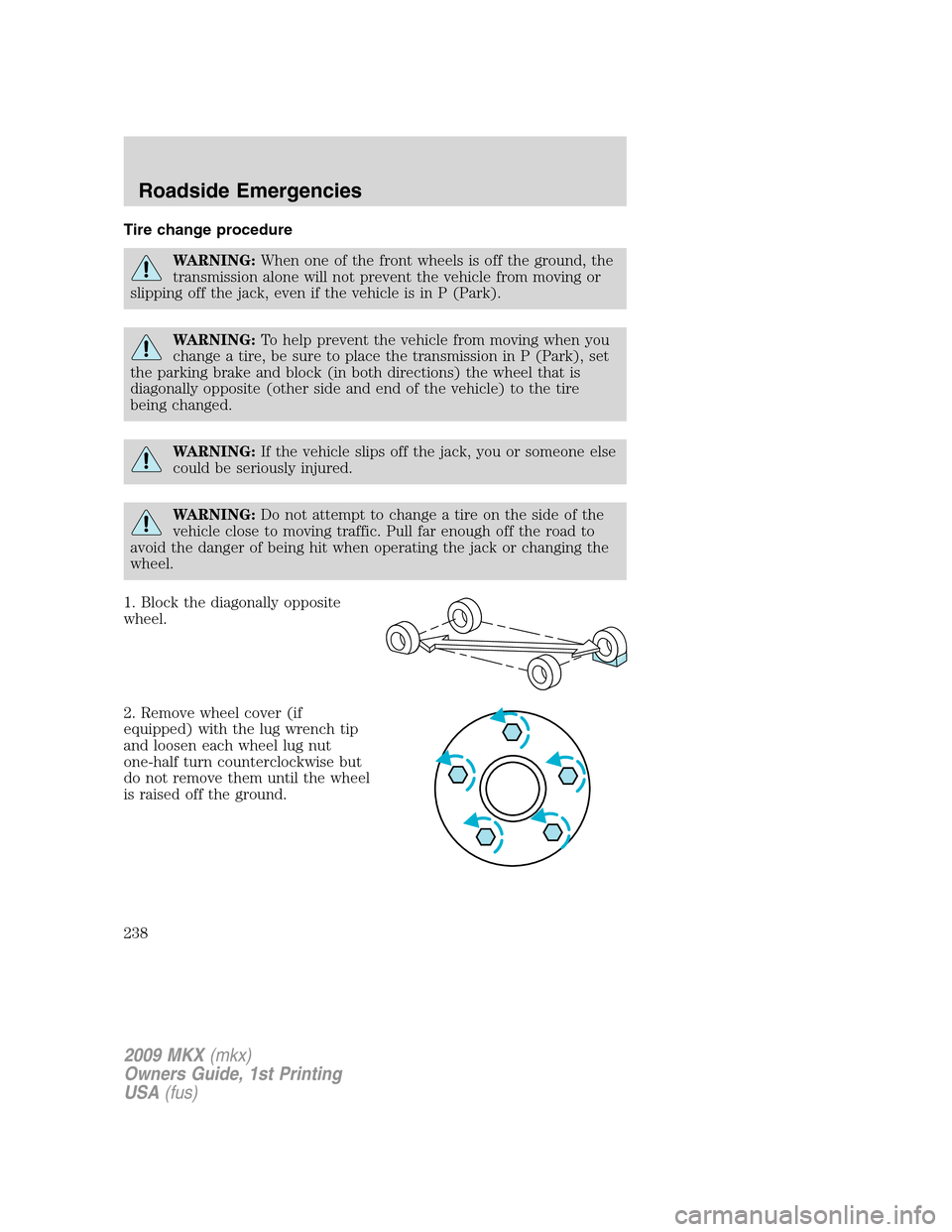
Tire change procedure
WARNING:When one of the front wheels is off the ground, the
transmission alone will not prevent the vehicle from moving or
slipping off the jack, even if the vehicle is in P (Park).
WARNING:To help prevent the vehicle from moving when you
change a tire, be sure to place the transmission in P (Park), set
the parking brake and block (in both directions) the wheel that is
diagonally opposite (other side and end of the vehicle) to the tire
being changed.
WARNING:If the vehicle slips off the jack, you or someone else
could be seriously injured.
WARNING:Do not attempt to change a tire on the side of the
vehicle close to moving traffic. Pull far enough off the road to
avoid the danger of being hit when operating the jack or changing the
wheel.
1. Block the diagonally opposite
wheel.
2. Remove wheel cover (if
equipped) with the lug wrench tip
and loosen each wheel lug nut
one-half turn counterclockwise but
do not remove them until the wheel
is raised off the ground.
2009 MKX(mkx)
Owners Guide, 1st Printing
USA(fus)
Roadside Emergencies
238
Page 239 of 307
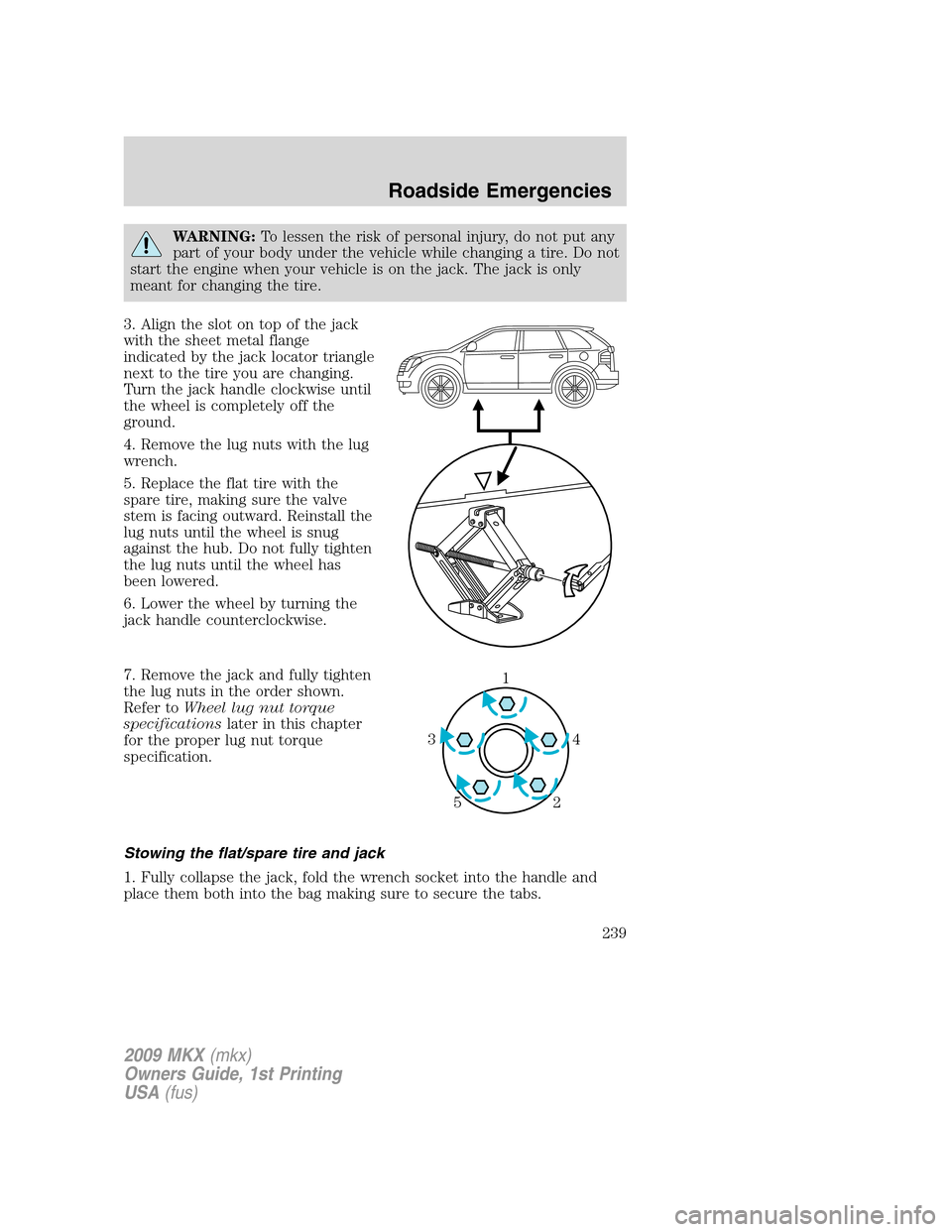
WARNING:To lessen the risk of personal injury, do not put any
part of your body under the vehicle while changing a tire. Do not
start the engine when your vehicle is on the jack. The jack is only
meant for changing the tire.
3. Align the slot on top of the jack
with the sheet metal flange
indicated by the jack locator triangle
next to the tire you are changing.
Turn the jack handle clockwise until
the wheel is completely off the
ground.
4. Remove the lug nuts with the lug
wrench.
5. Replace the flat tire with the
spare tire, making sure the valve
stem is facing outward. Reinstall the
lug nuts until the wheel is snug
against the hub. Do not fully tighten
the lug nuts until the wheel has
been lowered.
6. Lower the wheel by turning the
jack handle counterclockwise.
7. Remove the jack and fully tighten
the lug nuts in the order shown.
Refer toWheel lug nut torque
specificationslater in this chapter
for the proper lug nut torque
specification.
Stowing the flat/spare tire and jack
1. Fully collapse the jack, fold the wrench socket into the handle and
place them both into the bag making sure to secure the tabs.
1
4 3
2 5
2009 MKX(mkx)
Owners Guide, 1st Printing
USA(fus)
Roadside Emergencies
239
Page 240 of 307
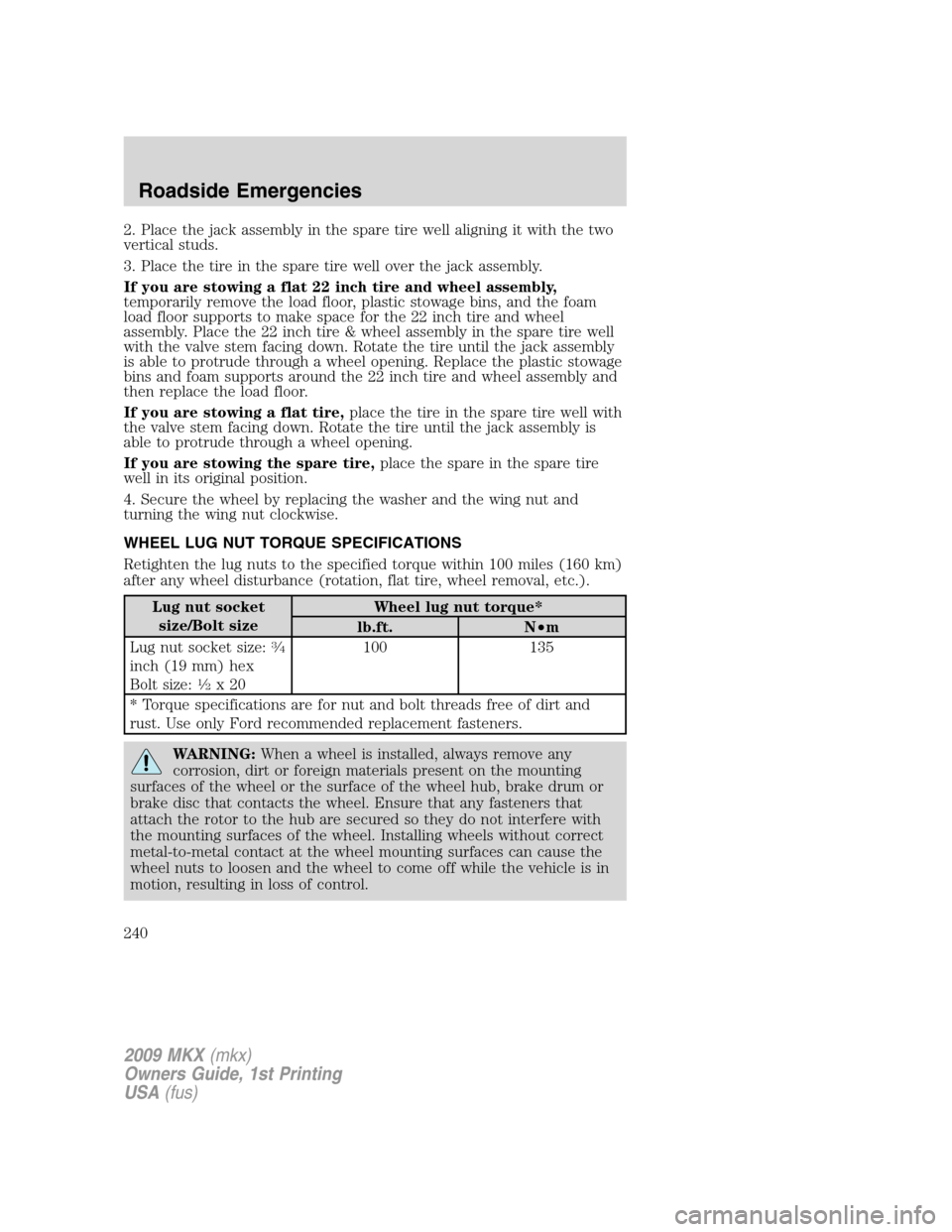
2. Place the jack assembly in the spare tire well aligning it with the two
vertical studs.
3. Place the tire in the spare tire well over the jack assembly.
If you are stowing a flat 22 inch tire and wheel assembly,
temporarily remove the load floor, plastic stowage bins, and the foam
load floor supports to make space for the 22 inch tire and wheel
assembly. Place the 22 inch tire & wheel assembly in the spare tire well
with the valve stem facing down. Rotate the tire until the jack assembly
is able to protrude through a wheel opening. Replace the plastic stowage
bins and foam supports around the 22 inch tire and wheel assembly and
then replace the load floor.
If you are stowing a flat tire,place the tire in the spare tire well with
the valve stem facing down. Rotate the tire until the jack assembly is
able to protrude through a wheel opening.
If you are stowing the spare tire,place the spare in the spare tire
well in its original position.
4. Secure the wheel by replacing the washer and the wing nut and
turning the wing nut clockwise.
WHEEL LUG NUT TORQUE SPECIFICATIONS
Retighten the lug nuts to the specified torque within 100 miles (160 km)
after any wheel disturbance (rotation, flat tire, wheel removal, etc.).
Lug nut socket
size/Bolt sizeWheel lug nut torque*
lb.ft. N•m
Lug nut socket size:
3�4
inch (19 mm) hex
Bolt size:1�2x20100 135
* Torque specifications are for nut and bolt threads free of dirt and
rust. Use only Ford recommended replacement fasteners.
WARNING:When a wheel is installed, always remove any
corrosion, dirt or foreign materials present on the mounting
surfaces of the wheel or the surface of the wheel hub, brake drum or
brake disc that contacts the wheel. Ensure that any fasteners that
attach the rotor to the hub are secured so they do not interfere with
the mounting surfaces of the wheel. Installing wheels without correct
metal-to-metal contact at the wheel mounting surfaces can cause the
wheel nuts to loosen and the wheel to come off while the vehicle is in
motion, resulting in loss of control.
2009 MKX(mkx)
Owners Guide, 1st Printing
USA(fus)
Roadside Emergencies
240